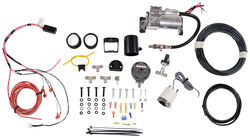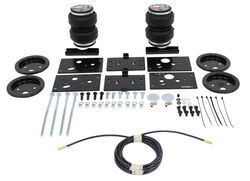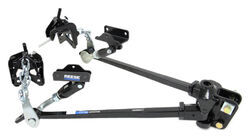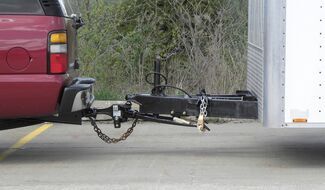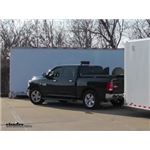
How to Properly Set up Weight Distribution With Air Bag Equipped 2017 Ram 2500
Question:
Good afternoon, Between our trailer and gear ATV+ we occasionally find ourselves pushing the capacity of our tow vehicle, in the 2400 - 2500 lb range. We do have a 1200 lb WD hitch set up by the RV dealer, as well as Timbrens that I installed. I was considering adding airbags to help support the heavy weight and attempting to smooth out the loaded ride. I have recently read articles stating running both the airbags and WD hitch they may actually work against each other. Between the price of upgrading to a one ton vehicle and the infrequency of actually towing that much I would rather implement a solution with my current vehicle, a 17 Ram 2500 w/ 6.7L diesel. I have considered adding airbags obviously, I also considered upgrading to a 2500 lb progressive coil springs. Any suggestions to help beef up the suspension and possibly smooth out the ride I do realize it’s a 3/4 ton truck though even if only for peace of mind, would be greatly appreciated. Thank you
asked by: Ken D
Expert Reply:
In some situations, air bags and weight distribution can work against each other if they're incorrectly set up, but they work best for two different purposes. Suspension enhancement works best for cargo carried in the bed of the truck, while weight distribution works best for leveling out the ride height from squat caused by a trailer's tongue weight compressing the rear truck suspension.
When the two systems are used together, the recommended method is to load up the truck as needed, then inflate the air bags to level the ride as much as possible. At that point, you hitch up the trailer and set up the weight distribution system as directed in its instructions. After setting up the w/d system initially you shouldn't need to do it again unless the weight of the trailer changes.
I'm unsure if the 2400-2500 lb weight you mentioned represents what's loaded in your truck bed or if that's the weight of your trailer. If you're using the Reese # RP66074 WD system rated for a maximum weight of 1200 lbs, your particular system will work best for trailers with tongue weights from 600-1200 lbs. The best place to start is to positively identify the trailer's tongue weight, which can be accomplished as shown in one of the methods shown in the articles I've linked for you. To that tongue weight figure, you need to add the weight of anything stowed in the truck bed behind the rear axle. If the trailer tongue weight plus that portion of the cargo in the bed is below 600 lbs or above 1200 lbs, your system won't function properly. It'll also need to be properly adjusted according to the instructions. If the system isn't set up with the proper ball height and the proper head tilt, it's not going to work correctly.
For an air bag system, I'd recommend the Air Lift # AL88289 Ultimate. This system has a 5000 lb capacity and features an internal jounce bumper for better stability. The system can be aired up using a standard compressor, but an onboard compressor system like # AL25854 would allow you to add or remove pressure from the system from the truck cab.
If the system you're using is the # RP66074, I'd recommend looking at the linked instructions and install video and resetting up the system from square one. Just because an RV dealer set up the system initially, it's not a guarantee that the system is set up correctly.
So, long story short. Make sure you set up things in the proper order. Load the truck bed. Inflate the air bags as desired. Then hitch up the w/d system. Make sure the system you're using is the correct one for the trailer's tongue weight plus the behind the axle truck bed cargo weight. Make sure the system is set up according to the instructions.

Products Referenced in This Question
Air Lift Load Controller Compressor System for Air Helper Springs- Heavy Duty - Single Path
- Air Suspension Compressor Kit
- Wired Control
- Single Path
- Analog Display
- Air Lift
more information >
Air Lift LoadLifter 5000 Ultimate Air Helper Springs with Internal Jounce Bumpers - Rear Axle
- Vehicle Suspension
- Rear Axle Suspension Enhancement
- Air Springs
- Heavy Duty
- Air Lift
more information >
Product Page this Question was Asked From
Strait-Line Weight Distribution w/ Sway Control - No Shank - Trunnion Bar - 12K GTW, 1,200 lbs TW
- Weight Distribution Hitch
- WD With Sway Control
- Some Sway
- Shank Not Included
- Electric Brake Compatible
- Fits 2 Inch Hitch
- Fits 2-1/2 Inch Hitch
- Allows Backing Up
- 1000 lbs
- 1100 lbs
- 700 lbs
- 800 lbs
- 900 lbs
- Reese
more information >
Featured Help Information
Instructions
Miscellaneous Media

Continue Researching
- Shop: Suspension Enhancement
- Q&A: Best Rear Suspension Enhancement For a 2024 Ram 2500 Towing a 5TH Wheel Trailer
- Shop: Air Lift LoadLifter 5000 Air Helper Springs - Rear Axle
- Video: Air Lift LoadLifter Air Helper Springs Installation - 2009 Dodge Ram Pickup
- Shop: Gooseneck Hitch
- Video: Air Lift Union T-Piece Review
- Shop: Air Lift LoadLifter 5000 Ultimate Air Helper Springs with Internal Jounce Bumpers - Rear Axle
- Shop: Air Lift WirelessONE Compressor System for Air Helper Springs - Remote - Bluetooth - EZ Mount
- Shop: Air Lift Union Tee for 1/4" Air Lines
- Shop: Air Lift LoadLifter 7500 XL Ultimate Air Helper Springs - Rear Axle
- Shop: B&W Turnoverball Underbed Gooseneck Trailer Hitch w/ Custom Installation Kit - 30,000 lbs
- Shop: Replacement Air Spring for Air Lift LoadLifter 7500 XL System - Rear Axle - Qty 1
- Q&A: Recommended Air Compressor w/ Auto Leveling
- Q&A: Will Air Lift LoadLifter 5000 Air Springs Work With B&W Turnoverball On 2021 Ram 2500 Short Bed
- Q&A: Choosing Between Air Lift Load Lifter 5000 or 7500 For 2018 Ram 2500 Towing 5th Wheel
- Q&A: Can Airlift 7500lb Bags Be Used With The 5000lb Airlift Kit On A 2017 Ram 2500
- Shop: Towing Mirrors
- Video: Air Lift LoadLifter Air Helper Springs Test Course
- Article: Choosing the Right Suspension Kit for Your Truck and Trailer
- Search Results: equalizer weight distribution hitch
- Q&A: Outer Diameter of Equal-i-zer Thin Walled Socket
- Q&A: Wrench for a Hitch Ball with 1-7/8 Inch Nut
- Video: Equal-i-zer Thin Walled Socket Review
- Shop: Truck Bed Sliding Tray
- Article: 5 Things to Know About Weight Distribution Hitches
- Shop: Tonneau Cover
- Search Results: retrax
- Shop: Ladder Rack
- Article: How to Carry Bikes While Towing a Travel Trailer
- Shop: Vehicle Cargo Control



